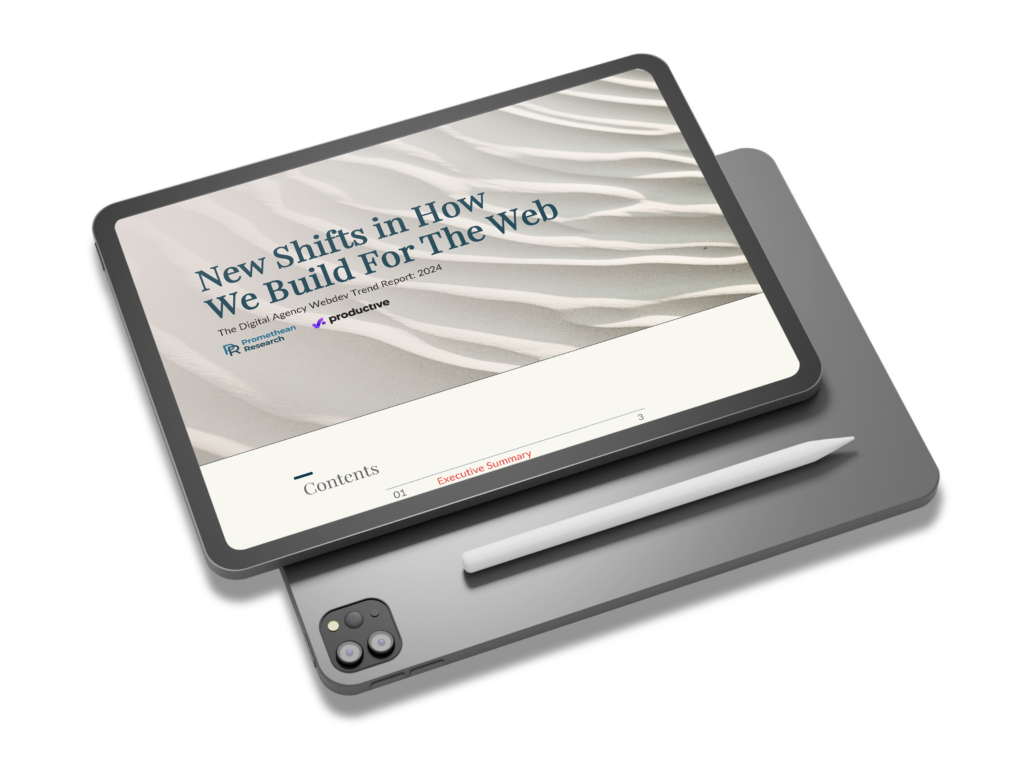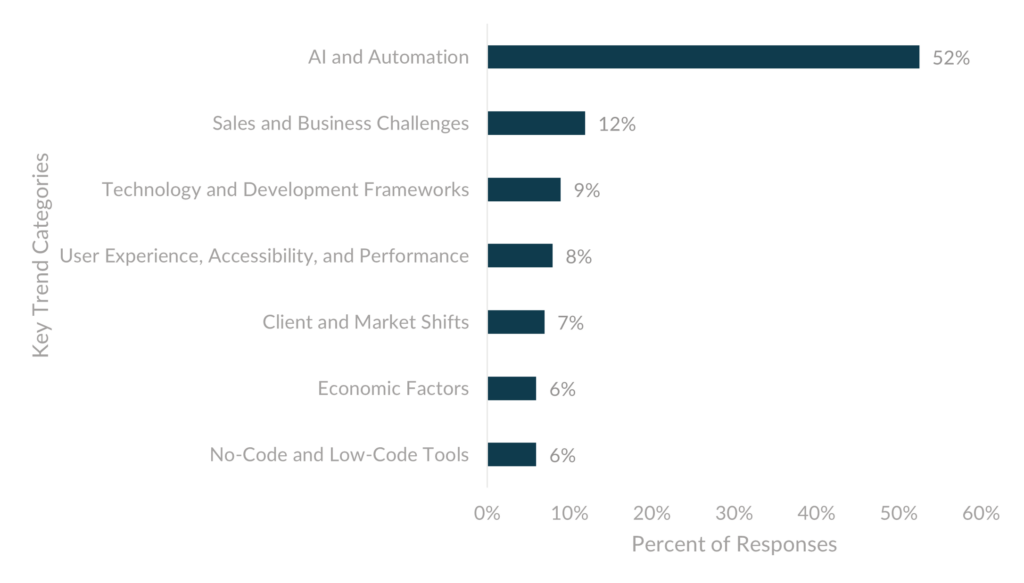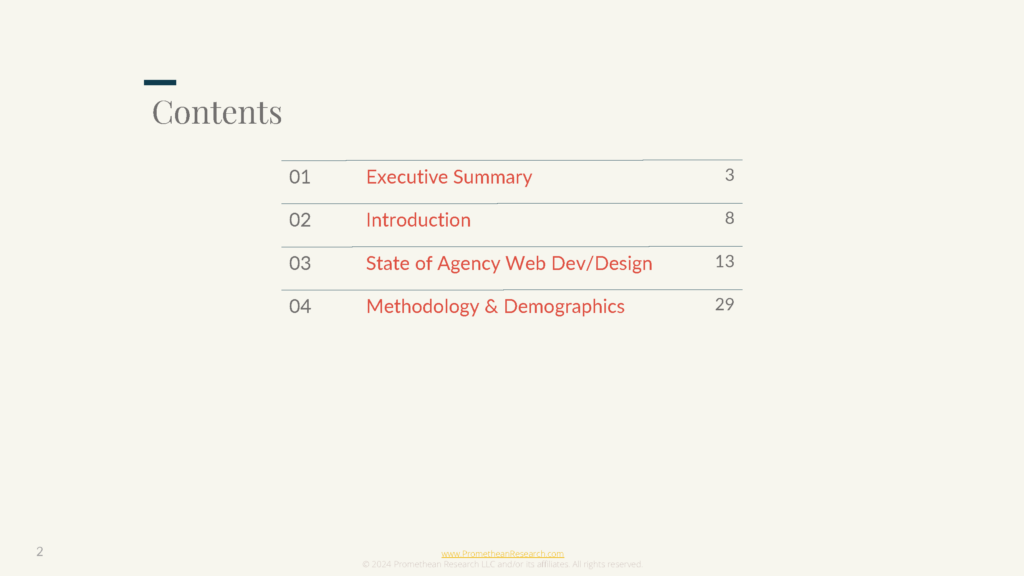Executive Summary
Agency Tool Evoloution
Our survey results indicate that AI and automation are significantly transforming the web development and design industry. 52% percent of respondents identified AI as a key trend impacting their work. Developers are increasingly utilizing AI for code generation, with half incorporating it into their workflow, while designers primarily use AI for image editing and enhancement. However, this increased efficiency has heightened client expectations for faster development and tighter project timelines.
We’re also seeing non-technical business challenges affecting the industry, with 33% of respondents citing factors such as sales hurdles, shifting client demands, and economic considerations. These challenges add complexity to operations, necessitating adaptations in processes, investments in training, and continuous learning to keep pace with evolving technologies. This pressure is compounded by the demanding nature of agency work, requiring a delicate balance between innovation and daily operational demands.
In terms of tools and project trends, Figma has emerged as the leading design platform, with 78% of designers primarily using it, followed by Adobe Illustrator. For developers, VS Code is the predominant text editor, favored by 70% of respondents.
The majority of agencies (85%) are constructing fewer than 25 websites annually, focusing on increasing the complexity and size of projects rather than the quantity.
Larger agencies are more inclined towards developing interactive applications, while smaller agencies and freelancers tend to handle transactional and e-commerce sites.
The industry is grappling with significant challenges, including budget constraints, client expectations, rapid technological changes, competition from various fronts, and time management pressures. These all affect how webdev/design work gets done.
Despite the hurdles, there is considerable enthusiasm about the future, particularly regarding the potential of artificial intelligence. Respondents were excited about AI’s ability to streamline tasks, streamline coding, and improve user experience.
The future looks, different. Not frightening, not rosy, but different. The way we build for the web is changing, and it’s imperative that agencies and creators change with it.
The Major Trends Affecting Webdev & Design at Digital Agencies
Survey respondents showed a strong focus on AI and Automation, with 52% citing them as one of the key trends impacting their web dev/design work right now.
Many respondents reported that adopting AI tools has significantly increased efficiency and productivity. Tasks are being completed faster and with greater ease, but these gains aren’t going unnoticed by clients. AI is also impacting web dev/design work by shifting client expectations around development speed, project timing, and pricing.
Non-tech business-related trends (Sales and Business Challenges, Client and Market Shifts, and Economic Factors) are having a massive impact, with 25% of our respondents citing them as a major trend affecting their work.
A substantial number of participants indicated that these trends add complexity to their work. This requires adapting to new processes, investing in training, and continuous learning to keep up with evolving technologies. This puts additional pressure on the agency and the individual to stay current. Pressure that’s in addition to everything else that must be balanced in this historically highly demanding industry.

“Thanks again for the helpful report. I’m a nerd for this stuff and your analysis is by far the best. I am now on my third stint growing digital agencies and always turn to your work.”
Alex Field
Senior Managing Director, Teal Media
AI Assistance
While a third of the respondents cited AI as a major trend, there’s a stark contrast in where AI is actually being used today.
For development tasks, half of those surveyed use AI to assist with code generation, while 15% don’t use AI for dev work at all.
When we asked about where they use AI for design-related tasks, we found that the most popular use case was in image editing or enhancement, but 41% of the respondents don’t use AI at all for their design-related work.
While many survey responses contained references to clients expecting more from AI than agencies could deliver, 11% reported that clients have requested that they not use AI assistance in their projects. This is likely due to security concerns as we saw in last year’s Digital Agencies & AI Report.
Development
& Design Tools
As we learned in previous surveys, developers and designers use multiple tools throughout their workflow. For this study, we wanted to understand where the bulk of their work was being done.
For designers, Figma was on top, with 78% of respondents saying they do most of their design work there. Adobe Illustrator was in second, while Sketch and Photoshop were tied for third.
VS Code came out as the clear winner when it came to text editors for developers, with 70% citing it as their text editor of choice. Sublime Text was a distant second place with only 14%, and everyone else was in single digits.
Site, Web
& Mobile Builds
To the right is a heat map showing the average number of websites, web apps, and mobile apps agencies build each year. The darker the color, the more responses.
Most agencies (85%) are building fewer than 25 websites a year for clients. Web apps make up a smaller portion and mobile app builds make up a tiny fraction of annual projects.
The average number of websites built by agencies doesn’t grow with the size of an agency. This furthers our view from How Digital Agencies Grow that agencies tend to grow by increasing their average project sizes vs. simply completing a greater number of projects.
On the other hand, web and mobile app builds tend to increase along with agency size. We believe this is mainly due to the more complex teams and skills required to successfully deliver these kinds of projects.
Types of Sites
Being Built
To the right is a heat map showing the average number of types of websites agencies build each year. The darker the color, the more responses.
When looking at the distribution of site builds, agencies in this survey tended to build slightly more complex informational-type builds and fewer interactive and application-style builds.
Agencies of all sizes built a similar distribution of both simple and complex informational sites, but transactional or ecommerce sites were more likely to be built by smaller agencies or individual freelancers. Conversely, and similar to what we saw on the previous page, interactive / application-style sites were more likely to be built by larger agencies.
Content Management Systems (CMS) Shifts
As expected, WordPress was the most commonly used CMS in our survey, with 83% of the respondents saying they use it currently. It also had by far the highest favorability rating in our sentiment analysis.
When we evaluated shifts in CMS usage, both Joomla and Drupal seemed to be falling out of favor, as 37% and 36% of respondents said they no longer use them, and they’re currently used by only a small portion of respondents.
Both Framer and Duda scored low in “No Longer Use,” and they were also incredibly low in representation. 94% of respondents never used Duda, and 92% never used Framer.
63% of respondents use the same number of CMSs as they did last year. 30% use more, while 7% use less. The main drivers for those using more CMSs include tech advancements (quality and flexibility), client requests, operational efficiencies, and cost considerations. Focus and specialization were the main drivers for those reducing the number of CMSs they use.
Content Management System Selection
There aren’t any hard and fast rules when it comes to how agencies select which CMS to use on a project. Each driver had a portion of respondents who said it had no impact and others who said it had a major impact on CMS selection.
With that said, some patterns were visible in the data. The type of site being built and dev/designer familiarity had fewer “No impact” responses and significantly more “Major impact” responses than average. Conversely, client deadlines had many more “No impact” responses and the second-fewest “Major impact” responses.
Get the Full Report
The 31-page report dives deeper into low-code and no-code use, sentiment, and benefits, plus a discussion on hosting decisions, common challenges, and opportunities.
Our latest insights on running digital agencies
Exclusive research opportunities, thoughts, and advice on the digital agency industry every two weeks.

"Best / most valuable updates from anyone in ages. I get hit up soooooo much, keep this kind of newsletter / value up."
Wil Reynolds
CEO, Seer Interactive



